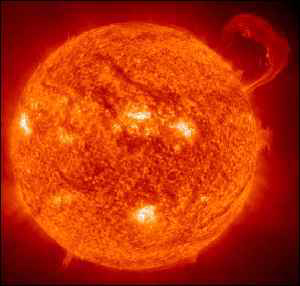Coronal Mass Ejections on the Sun
 |
Source: BBC News Online.
|
Coronal mass ejections (CMEs) are huge bubbles of coronal plasma threaded by intense magnetic field lines that are ejected from the Sun over the course of several hours. CMEs often look like huge, twisted rope, which scientists call "flux rope."
CMEs often occur along with solar flares (explosions on the Sun's surface), but they can also occur spontaneously. The frequency of CMEs varies with the 11 year solar cycle. At solar minimum we observe about one a week. Near solar maximum we observe an average of two to three CMEs per day. CMEs disrupt the flow of the solar wind and cause disturbances that can damage systems in near-Earth and on Earth's surface.
Their magnetic fields merge between the interplanetary magnetic field (IMF) and geomagnetic field lines. This direct link between even a small percentage of the geomagnetic field lines and the IMF results in large increases in the rate of energy transfer from the solar wind and the magnetosphere. Because of this, CMEs are among the most important drivers of geomagnetic storms and substorms. These substorms cause the beautiful northern and southern auroral light that often are seen in the night sky at high latitudes.
Back